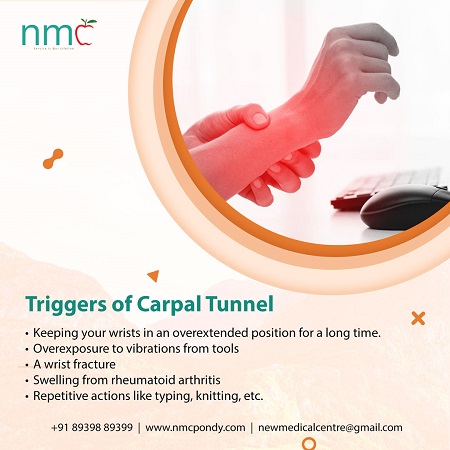Carpal Tunnel Syndrome: Causes and Treatment
Oct 05, 2022 What is Carpal Tunnel Syndrome?
What is Carpal Tunnel Syndrome?
Carpal tunnel syndrome (CTS) is one of the most common of conditions that affect the hand or hands. The common signs of the presence of the problem are pain, tingling sensation, weakness and/or general numbness in the hand or wrist. This is a medical condition that has been known for a very long time, but it has become a well-known ailment with the onset of the electronic age and the increased use of computers. There is a mistaken impression that it affects only office workers and in particular those who spend time working on computers and electronic equipment. The assumption is that continuous typing and the use of the mouse cause stress to the hands and wrists resulting in the onset of CTS. The fact is thatit can affect anyone who is involved in any activity, including sports and pastimes, that require repeated use of the hands and wrists. CTS affects people who do not and never have worked in an office or spent time on computers.
The carpal tunnel is a narrow tube in the wrist. Similar to a tunnel that a car or train passes through, the carpal tunnel is the conduit through which the nerves and tendons that control the movement of the wrists, hands and fingers pass through. When the tunnel becomes compressedor when there is increased pressure on the nerves and tendons, CTS can develop.
Causes
Any repetitive motion of the wrist, hand or fingers can result in the development of CTS. Among the most common of these are extreme wristmotions, continuous stress on the hands and wrists, vibration and repeated high force or impact.
Many factors could contribute to the development of CTS. These include, but are not limited to:
- Genetic or Hereditary Factors - If others in the family have CTS, you are more likely to develop the condition.
- Hand or wrist deformity
- Injury
- Pregnancy
- Medical procedures such as haemodialysis
- Dislocation of the wrist
- Diseases such as diabetes, gout or rheumatoid arthritis
- Thyroid gland related hormonal imbalance
- Old age
- Excessive alcohol consumption over a long period of time
- A tumor in the hand or wrist
- Excessive protein deposits in the carpal tunnel
While both sexes suffer from CTS, statistics show that it is more common in women than men.
Also Read: Causes, Symptoms and Treatment of Cervical Spondylosis
Treatment
Both surgical and non-surgical treatment options exist for CTS. Only a doctor will be able to decide which option is the best for each patient.That said, non-surgical treatments are used for less severe cases while surgery is often recommended for more serious cases. Because surgical options have a very high positive outcome rate, they may be used when the effectiveness of non-surgical options is doubtful for less serious cases.
Non-Surgical Treatments
Non-surgical treatment typically consists of one or a combination of the following:
- Wearing a wrist splint to relieve the stress on the wrist and the carpal tunnel
- Cortisone injections
- Taking nonsteroidal anti-inflammatory drugs (NSAIDs)
- Physiotherapy to reduce pressure on the tunnel
- Heat treatment
Besides these direct medical interventions, environmental changes are often prescribed to reduce the symptoms of CTS. These changes could be to the home or the workplace or, frequently, to both and include:
- Altering the height of a chair in which you spend a great deal of time.
- Changing the chair to increase support to the spine and the forearms.
- Changing the position of a computer keyboard, mouse and other desktop equipment.
- Modifying the posture and the position of the hands and wrists while performing tasks, especially repetitive ones or those that cause sudden stress or impact to the hands and wrists.
 Surgical Treatments
Surgical Treatments
Surgery is advised if CTS does not respond to other treatments or if the condition is so severe that non-surgical options will not work. The object of the surgery is to increase the size of the carpal tunnel to decrease the pressure on the nerves and tendons that pass through it. One way of doing this is by surgically releasing the ligament that covers the tunnel at the base of the palm to reduce the constriction.
- The surgery itself is an outpatient procedure done under local anaesthesia. In some cases, perhaps because of other medical factors, your doctor may recommend that it be done under general anaesthesia.
- The surgery will require a 3-to-4-day recovery period, although some degree of relief may often be felt immediately after the surgery. During the recovery period, there may be some general post-surgical pain or discomfort. If it is too severe, pain reduction medication will be prescribed.
- Stitches will be removed about 2 weeks after the surgery and exercise programmes to restore strength and flexibility to the hands, fingers and wrists will begin.
- While recovery time will vary according to age and other medical factors, full recovery will typically take 4 to 6 weeks.
- Over the next few months,strength and sensation will gradually return to the wrists, hands and fingers.
Also Read: Herniated Disk: When Is Surgery Needed?
CTS is not a life-threatening condition, but it is one that should not be ignored. Occasional slight pain in the wrists, hands or fingers after long periods of work or repetitive activity is common. However, if thepain is severe or the functionality of the hands is affected, then it could be CTS. When CTS is suspected, the sooner the condition is diagnosed and treatment started,faster the recovery. If you suspect youhave CTS, go to a multispecialty hospital where there will be orthopaedic and other specialists and medical facilities to provide you with both the most accurate diagnosis and the best treatment for the condition. Any ailment that affects the functioning of the hands can have a negative impact on your life and delay in obtaining a diagnosis and starting treatment may leave you with long-term problems that will require more extensive treatment and a longer recovery period.
Comments - 0
Share Your Thoughts
SEARCH
RECENT BLOGS
CATEGORIES
7 Proven Ways to Live a Heart Healthy Life
Common Heart Procedures An Overview
Common Tests To Diagnose Heart Disease
All You Need To Know About Coronary Artery Disease
How to Manage Stress at Work? | Heart Health
How Good Sleep Can Keep Your Heart Healthy
Angioplasty and Stent Placement - How Is It Done?
Minimally Invasive Radiofrequency Ablation for Irregular Heartbeat
Causes of Hair Fall and Prevention
All You Need To Know About Abdominoplasty Or Tummy Tuck Surgery
All You Need to Know About PRP Treatment
What Is Cosmetic Surgery? What are the types of Cosmetic Surgery?
Staying Healthy During A Pandemic
Healthcare in the Post COVID-19 World
Emergency Response When Experiencing Difficulty in Breathing
First Aid for Seniors – Special Precautions and Needs
The Importance of Medical Care for Patients Who Have Only About 6 Months to Live
Vertigo - Symptoms, Causes, and Treatment
Middle Ear Infection And Treatment
Can Diabetes be cured permanently?
The Importance of Health Packages in Staying Healthy
Whom to See First? General Physician or Specialist?
Knowing When to Go to the Hospital
How to Find the Right Hospital Near You?
Why Multispecialty Hospitals Are the Best
The Link Between Diabetes And Obesity
Pain in Sole of the Foot – Do Not Ignore It
The Dangers of Antibiotic Misuse
What causes excessive burping?
Acid Reflux Should Not Be Ignored
What is Irritable Bowel Syndrome
The Importance Of Limiting Time On Tech Devices For Children
Sitting Too Much and Heart Health: The Link
Health Risks While Returning to Work after the Lockdown
A South Indian Diet Plan For Heart Patients
Symptoms You Should Never Ignore
Traumatic Brain Injury - Causes, Symptoms and Treatments
5 Things to Know About Cerebral Palsy
Spotting Early Signs of Dementia
List of Common Urogynaecology Surgical Procedures
Tips for Successful Breast Feeding
The Importance of Regular Gynaecological Examinations
How To Find The Best Gynecologist
Vaginal Discharge - When Should You See A Doctor
In Vitro Fertilization (IVF) – What You Need To Know
Premenstrual Syndrome - Understanding and Dealing with It
What You Need to Know About Ovarian Cyst
Menopause Is Normal but That Does Not Mean It May Not Need Treatment
Uterine Fibroids May Be Common, but the Condition Should Not Be Ignored
What You Need to Know About Menstrual Pain and Cramps?
பெண்ணுறுப்பு புற்றுநோய்க்கான அபாயத்தைக் குறைக்கும் ஆரோக்கியமான பழக்க வழக்கங்கள்
The Importance of Self Breast Examination
Understanding the Various Stages of Lung Cancer
Can Lung Cancer Be Diagnosed Without a Biopsy?
Healthy Habits That Can Help Deal with Lung Cancer
Understanding Cancer – The First Step In Dealing With It – Part 1
Understanding Cancer - The First Step In Dealing With It - Part 2
HPV Vaccination – Protection against Cervical and Other Cancers
கீல்வாத மூட்டுவலி என்பது என்ன?
Herniated Disk: When Is Surgery Needed?
Causes, Symptoms and Treatment of Cervical Spondylosis
Carpal Tunnel Syndrome: Causes and Treatment
Do Brittle Bones and Hormones Have a Connection?
Paediatric Care – Choosing the Right Hospital
Immunization Chart For The Ages Of 0 To 3 Years
Regular Health Checkups for Children Are Vital for Long-Term Good Health
Psychological Trauma after an accident
Sleep Disorders - Causes and Treatment
மாரடைப்பின் எச்சரிக்கை அறிகுறிகளை அறியுங்கள் – தாமதிக்காமல் செயல்படுங்கள்!
எண்டோகிரைன் கோளாறுகள் - வகைகள், காரணங்கள், அறிகுறிகள், நோய் கண்டறிதல் மற்றும் சிகிச்சை வகைகள்
இதய நோயாளிகளுக்கான உணவுமுறைத்திட்டம்
குழந்தை சாப்பிட வம்பு பண்ணும் பழக்கத்தை சரி செய்யும் வழிகள்
ஸ்ட்ரோக் - சிகிச்சையும் பாதுகாப்பும்
நுரையீரல் புற்றுநோய்க் காரணிகள்
குழந்தைகள் பொருட்களை விழுங்கிவிட்டால் என்ன செய்வது
வாழ்க்கை முறை மாற்றங்கள் மூலம் கொலஸ்ட்ரால் அளவைக் குறைப்பது எப்படி?
வைட்டமின் டி குறைபாட்டினை நிவர்த்தி செய்யும் வழிகள்
தோல் வியாதிகள் மற்றும் அவற்றைப் புறக்கணிப்பதால் ஏற்படும் அபாயங்கள்
இதய நோய்ச் சிகிச்சையில் தொழில்நுட்ப முன்னேற்றங்கள்
மனநல நோய்கள் குணப்படுத்தப் படக் கூடியவை, கவலை வேண்டாம்!
செர்விகல் ஸ்போண்டிலோசிஸ் – காரணங்கள் மற்றும் சிகிச்சை
கீழ் முதுகுவலி மீண்டும் வராமல் தடுக்க சில வாழ்க்கை முறை மாற்றங்கள்
வறண்ட தொண்டைப் புண் - காரணங்கள் மற்றும் சிகிச்சை
ஆஸ்துமாவுடன் வாழ்வது – நாம் தெரிந்து கொள்ள வேண்டிய விஷயங்கள்
செவித்திறன் இழப்பு - காரணங்கள் மற்றும் தடுப்பு

